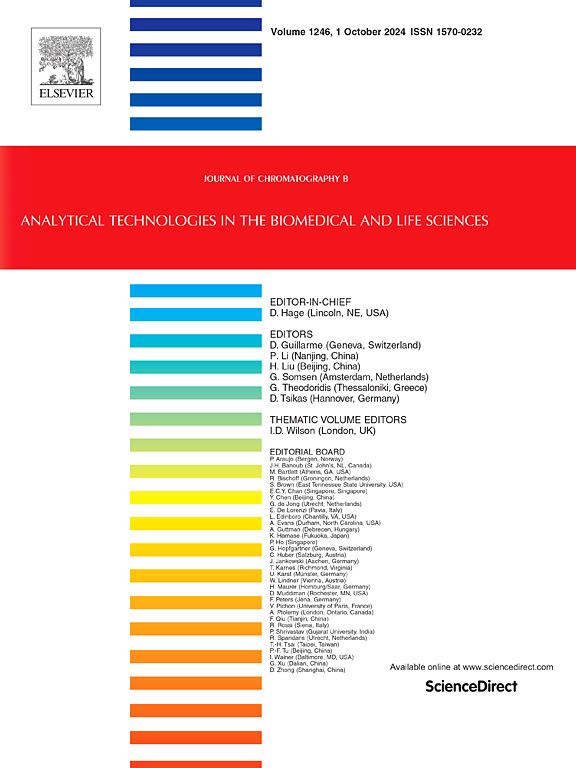Comprehensive LC-MS/MS and HPLC-based profiling of secondary metabolites in Aster incisus from diverse cultivation regions
IF 2.8
3区 医学
Q2 BIOCHEMICAL RESEARCH METHODS
引用次数: 0
Abstract
Aster incisus is a perennial herbaceous plant belonging to the Asteraceae family, known for its pharmacologically active secondary metabolites. In this study, we conducted a comparative profiling and quantification of secondary metabolites in A. incisus extracts cultivated in two regions, Eumseong (AIE) and Inje (AII), using liquid chromatography-tandem mass spectrometry (LC-MS/MS) and high-performance liquid chromatography with a variable wavelength detector (HPLC/VW). LC-MS/MS analysis conducted in negative ion mode enabled the identification of 13 secondary metabolites, including key flavonoids and phenolic acids such as chlorogenic acid, narcissoside, isorhamnetin, and rutin. HPLC quantification revealed distinct compositional differences between the AIE and AII samples. The AII extract contained significantly higher levels of chlorogenic acid (35.97 mg/g extract), narcissoside (8.08 mg/g extract), and isorhamnetin 3-galactoside (23.79 mg/g extract), while the AIE extract exhibited greater concentrations of protocatechuic acid (0.77 mg/g extract), rutin (2.08 mg/g extract), and hirsutrin (2.05 mg/g extract). Isorhamnetin was detected exclusively in AII (0.24 mg/g extract), and a number of other compounds were present only in trace amounts in both samples. These results suggest that environmental and geographical factors play a significant role in the biosynthesis of phenolic and flavonoid compounds in A. incisus. These findings provide critical chemotaxonomic and pharmacological insights into the region-dependent accumulation of bioactive metabolites, highlighting their potential relevance in drug discovery and therapeutic formulation based on natural products.
基于LC-MS/MS和hplc的不同栽培地区紫菀次生代谢物综合分析
紫菀是紫菀科多年生草本植物,以其具有药理活性的次生代谢产物而闻名。本研究采用液相色谱-串联质谱(LC-MS/MS)和高效液相色谱-可变波长检测器(HPLC/VW)技术,对阴城(AIE)和仁泽(AII)两个地区种植的切牙草提取物的次生代谢产物进行了对比分析和定量分析。在负离子模式下进行LC-MS/MS分析,鉴定出13种次生代谢物,包括绿原酸、水仙苷、异鼠李素、芦丁等关键黄酮和酚酸。HPLC定量分析显示AIE和AII样品的成分存在明显差异。AII提取物中绿原酸(35.97 mg/g)、水仙苷(8.08 mg/g)和异鼠李素3-半乳苷(23.79 mg/g)含量显著高于AIE提取物,而原儿茶酸(0.77 mg/g)、芦丁(2.08 mg/g)和毛素(2.05 mg/g)含量显著高于AIE提取物。异鼠李素仅在AII (0.24 mg/g提取物)中检测到,而许多其他化合物仅在两种样品中以微量存在。上述结果表明,环境和地理因素在切牙草酚类和类黄酮类化合物的生物合成中起着重要作用。这些发现为生物活性代谢物的区域依赖性积累提供了重要的化学分类学和药理学见解,突出了它们在药物发现和基于天然产物的治疗方案中的潜在相关性。
本文章由计算机程序翻译,如有差异,请以英文原文为准。
求助全文
约1分钟内获得全文
求助全文
来源期刊

Journal of Chromatography B
医学-分析化学
CiteScore
5.60
自引率
3.30%
发文量
306
审稿时长
44 days
期刊介绍:
The Journal of Chromatography B publishes papers on developments in separation science relevant to biology and biomedical research including both fundamental advances and applications. Analytical techniques which may be considered include the various facets of chromatography, electrophoresis and related methods, affinity and immunoaffinity-based methodologies, hyphenated and other multi-dimensional techniques, and microanalytical approaches. The journal also considers articles reporting developments in sample preparation, detection techniques including mass spectrometry, and data handling and analysis.
Developments related to preparative separations for the isolation and purification of components of biological systems may be published, including chromatographic and electrophoretic methods, affinity separations, field flow fractionation and other preparative approaches.
Applications to the analysis of biological systems and samples will be considered when the analytical science contains a significant element of novelty, e.g. a new approach to the separation of a compound, novel combination of analytical techniques, or significantly improved analytical performance.
 求助内容:
求助内容: 应助结果提醒方式:
应助结果提醒方式:


